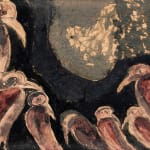Rabindranath Tagore
Untitled (Birds), 1930
Watercolour, coloured inks and graphite on paper
23 x 31 cm
9 x 12 1/4 in
9 x 12 1/4 in
Signed and inscribed on the reverse of the backboard 'To Richard Elmhirst/ Wishing him an abundance of Love as the best harvest of life/ Rabindranath Tagore/ June 14, 1930'
Further images
Leonard Elmhirst met Rabindranath Tagore at Cornell University in the early 1920s. They frequently travelled together, and it was at Tagore’s suggestion that Dartington was acquired and the institution established....
Leonard Elmhirst met Rabindranath Tagore at Cornell University in the early 1920s. They frequently travelled together, and it was at Tagore’s suggestion that Dartington was acquired and the institution established. Tagore first visited the Estate in 1926 and would have met Richard Elmhirst, who by then was living and working there. Tagore returned to Dartington for a second time in July 1930. According to the archives, Tagore; ‘One day asked for bottles of coloured ink and, when these arrived, there began to emerge a series of paintings and sketches.’
Richard Elmhirst (1900 – 1978) was Leonard’s younger brother and moved to Dartington shortly after it was bought in 1925. On the 14th June 1930 he married Loise Soelberg (1903-1994), and were gifted this painting by Tagore. On the back of the frame there is a card with an inscription;
To Richard Elmhirst
Wishing him an abundance of love as the best harvest of life
Rabindranath Tagore
June 14, 1930
Information from the Dartington Hall Archives shows that Tagore arrived on the 6th June 1930 and stayed until the 1st July.
Friday 6th June 1930
‘Arrivals and departures: Dr Rabindranath Tagore and Mr Williams.’
Friday, 13th June 1930
‘Wedding: Richard Elmhirst and Louise Soelberg will be married on Saturday morning. There will be a gathering on
the Bowling Green at the Hall at 10am and it is hoped that everyone will feel that their working clothes make the
happiest wedding garments.’
Tuesday 1st July 1930
‘Arrivals and departures: Dr Rabindranath Tagore leaves on Thursday’
News of the Day, Friday, 6th June 1930, Vol. 4
Richard and Louise had one daughter but separated a few years later, Richard emigrating to the USA. The painting was then bought by a British collector in either Birmingham or London in the 1950s. He and his wife had eclectic taste, and their home was filled with African sculpture and works by the Indian painters Francis Newton Souza and Avinash Chandra.
Tagore’s career as a painter starts around 1928. His earliest visual work began with doodles that turned crossed-out words and lines into images that became expressive and sometimes grotesque forms. They were unplanned and shaped by accidents and intuitive decisions. Many of them represent animals described by Tagore as "a probable animal that had unaccountably missed its chance of existence" or "a bird that only can soar in our dreams".
1930 saw Tagore’s first public exhibition at Galerie Pigalle in Paris. This was followed by exhibitions at Birmingham City Museum and Art Gallery and the Indian Society, London. From England, Tagore continues his tour of Europe, meeting Albert Einstein on 14th July 1930. This painting by Tagore is from an important stage of his career and is closely linked with key figures of the time.
Richard Elmhirst (1900 – 1978) was Leonard’s younger brother and moved to Dartington shortly after it was bought in 1925. On the 14th June 1930 he married Loise Soelberg (1903-1994), and were gifted this painting by Tagore. On the back of the frame there is a card with an inscription;
To Richard Elmhirst
Wishing him an abundance of love as the best harvest of life
Rabindranath Tagore
June 14, 1930
Information from the Dartington Hall Archives shows that Tagore arrived on the 6th June 1930 and stayed until the 1st July.
Friday 6th June 1930
‘Arrivals and departures: Dr Rabindranath Tagore and Mr Williams.’
Friday, 13th June 1930
‘Wedding: Richard Elmhirst and Louise Soelberg will be married on Saturday morning. There will be a gathering on
the Bowling Green at the Hall at 10am and it is hoped that everyone will feel that their working clothes make the
happiest wedding garments.’
Tuesday 1st July 1930
‘Arrivals and departures: Dr Rabindranath Tagore leaves on Thursday’
News of the Day, Friday, 6th June 1930, Vol. 4
Richard and Louise had one daughter but separated a few years later, Richard emigrating to the USA. The painting was then bought by a British collector in either Birmingham or London in the 1950s. He and his wife had eclectic taste, and their home was filled with African sculpture and works by the Indian painters Francis Newton Souza and Avinash Chandra.
Tagore’s career as a painter starts around 1928. His earliest visual work began with doodles that turned crossed-out words and lines into images that became expressive and sometimes grotesque forms. They were unplanned and shaped by accidents and intuitive decisions. Many of them represent animals described by Tagore as "a probable animal that had unaccountably missed its chance of existence" or "a bird that only can soar in our dreams".
1930 saw Tagore’s first public exhibition at Galerie Pigalle in Paris. This was followed by exhibitions at Birmingham City Museum and Art Gallery and the Indian Society, London. From England, Tagore continues his tour of Europe, meeting Albert Einstein on 14th July 1930. This painting by Tagore is from an important stage of his career and is closely linked with key figures of the time.
Provenance
Gifted by the Artist to Richard Elmhirst as a wedding present, 14 June 1930;
Private UK collection (acquired in either London or Birmingham in the
1950s);
Thence by descent;
Grosvenor Gallery, LondonExhibitions
South Asian Modern Art 2023, Grosvenor Gallery, London, 8-30 June, No.2, (illustrated in the exhibition catalogue)1
of
35
















